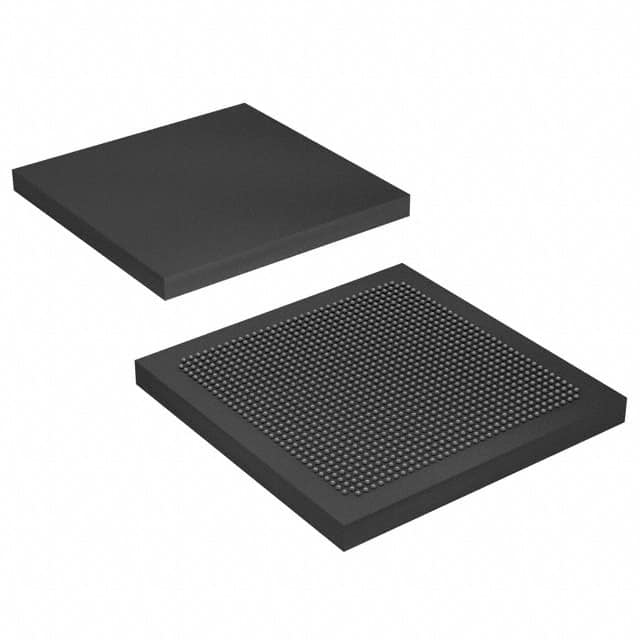Consulte las especificaciones para obtener detalles del producto.

5SGXMA4K2F35I2N
Product Overview
Category
The 5SGXMA4K2F35I2N belongs to the category of Field-Programmable Gate Arrays (FPGAs).
Use
This FPGA is designed for high-performance applications that require complex digital logic circuits. It provides a flexible and customizable solution for various industries, including telecommunications, automotive, aerospace, and industrial automation.
Characteristics
- High-density integration: The 5SGXMA4K2F35I2N offers a large number of programmable logic elements, allowing for the implementation of complex designs.
- High-speed performance: With advanced architecture and optimized routing resources, this FPGA can operate at high clock frequencies, enabling rapid data processing.
- Low power consumption: The device incorporates power-saving features, ensuring efficient energy usage without compromising performance.
- Robust design: The 5SGXMA4K2F35I2N is built to withstand harsh operating conditions, making it suitable for demanding environments.
- Scalability: It supports various I/O standards and interfaces, facilitating seamless integration with other components.
Package and Quantity
The 5SGXMA4K2F35I2N is available in a compact and durable package, ensuring easy handling and protection during transportation and installation. The exact packaging and quantity depend on the supplier and customer requirements.
Specifications
- Logic Elements: 462,000
- Embedded Memory: 12,288 Kbits
- DSP Blocks: 1,526
- Maximum User I/Os: 1,040
- Transceivers: 96
- Operating Voltage: 1.0V - 1.2V
- Operating Temperature Range: -40°C to 100°C
- Package Type: F35 (35mm x 35mm)
Detailed Pin Configuration
The 5SGXMA4K2F35I2N has a comprehensive pin configuration, allowing for versatile connectivity and integration. The detailed pinout information can be found in the product datasheet provided by the manufacturer.
Functional Features
- High-speed data processing: The FPGA's advanced architecture enables efficient parallel processing, resulting in accelerated computation and improved system performance.
- Flexible reconfiguration: The device can be reprogrammed multiple times, allowing for quick design iterations and adaptability to changing requirements.
- Embedded memory resources: The integrated memory blocks provide additional storage capacity, reducing the need for external memory components.
- Configurable I/O standards: The FPGA supports various industry-standard interfaces, enabling seamless communication with other devices.
- Built-in security features: The 5SGXMA4K2F35I2N incorporates security mechanisms to protect sensitive data and prevent unauthorized access.
Advantages and Disadvantages
Advantages
- High-performance capabilities
- Customizable and flexible design
- Low power consumption
- Robust construction for harsh environments
- Scalable and compatible with different interfaces
Disadvantages
- Relatively high cost compared to other programmable logic devices
- Steeper learning curve for programming and utilization
Working Principles
The 5SGXMA4K2F35I2N operates based on the principles of field-programmable gate arrays. It consists of an array of configurable logic elements interconnected through programmable routing resources. These logic elements can be programmed to implement various digital functions, such as arithmetic operations, memory storage, and control logic. The FPGA's behavior is determined by the configuration data loaded into its internal memory, which defines the interconnections and functionality of the logic elements.
Detailed Application Field Plans
The 5SGXMA4K2F35I2N finds applications in diverse fields, including:
- Telecommunications: Used in high-speed data transmission systems, network routers, and switches.
- Automotive: Employed in advanced driver assistance systems (ADAS), engine control units (ECUs), and infotainment systems.
- Aerospace: Utilized in satellite communication systems, avionics, and flight control systems.
- Industrial Automation: Applied in programmable logic controllers (PLCs), robotics, and process control systems.
Detailed and Complete Alternative Models
- 5SGXEA7K2F40C2N
- 5SGXEB6R2F40I2N
- 5SGXEB6R3F43I2N
- 5SGXEB6R3F45I2N
- 5SGXEB6R3F47I2N
These alternative models offer similar features and capabilities to the 5SGXMA4K2F35I2N, providing options for different project requirements and budgets.
Note: The content provided above is a sample structure for an encyclopedia entry and may not reflect actual specifications or details of the mentioned product.
Enumere 10 preguntas y respuestas comunes relacionadas con la aplicación de 5SGXMA4K2F35I2N en soluciones técnicas
Sure! Here are 10 common questions and answers related to the application of 5SGXMA4K2F35I2N in technical solutions:
Q: What is the 5SGXMA4K2F35I2N FPGA used for? A: The 5SGXMA4K2F35I2N is a Field-Programmable Gate Array (FPGA) that can be used for various applications such as high-performance computing, networking, and signal processing.
Q: What are the key features of the 5SGXMA4K2F35I2N FPGA? A: Some key features include a large number of logic elements, high-speed transceivers, embedded memory blocks, and support for various communication protocols.
Q: Can the 5SGXMA4K2F35I2N FPGA be reprogrammed? A: Yes, FPGAs are designed to be reprogrammable, allowing users to modify the functionality of the device even after it has been deployed.
Q: How can the 5SGXMA4K2F35I2N FPGA be programmed? A: The 5SGXMA4K2F35I2N FPGA can be programmed using hardware description languages (HDLs) such as VHDL or Verilog, or through graphical programming tools provided by the FPGA manufacturer.
Q: What are some typical applications of the 5SGXMA4K2F35I2N FPGA? A: This FPGA can be used in applications like high-frequency trading, video processing, wireless communication systems, radar systems, and data center acceleration.
Q: Does the 5SGXMA4K2F35I2N FPGA support high-speed serial communication? A: Yes, the 5SGXMA4K2F35I2N FPGA has built-in high-speed transceivers that support protocols like PCIe, Ethernet, and Serial RapidIO.
Q: Can the 5SGXMA4K2F35I2N FPGA interface with external memory devices? A: Yes, this FPGA has embedded memory blocks and can also interface with external memory devices such as DDR3 or DDR4 SDRAM.
Q: What is the power consumption of the 5SGXMA4K2F35I2N FPGA? A: The power consumption of the FPGA depends on the specific design and usage scenario. It is recommended to refer to the device datasheet for detailed power specifications.
Q: Are there any development boards available for the 5SGXMA4K2F35I2N FPGA? A: Yes, the FPGA manufacturer provides development boards that allow users to prototype and test their designs using the 5SGXMA4K2F35I2N FPGA.
Q: Can the 5SGXMA4K2F35I2N FPGA be used in safety-critical applications? A: While FPGAs can be used in safety-critical applications, it is important to ensure proper design, verification, and validation processes are followed to meet the required safety standards.
Please note that the answers provided here are general and may vary depending on the specific requirements and use cases of the application.

